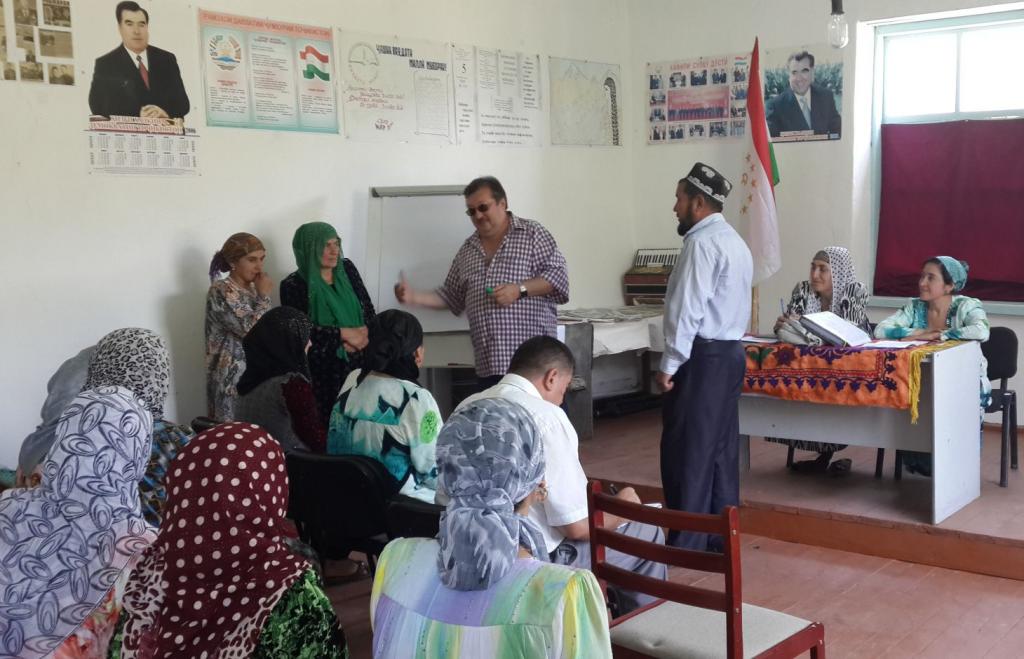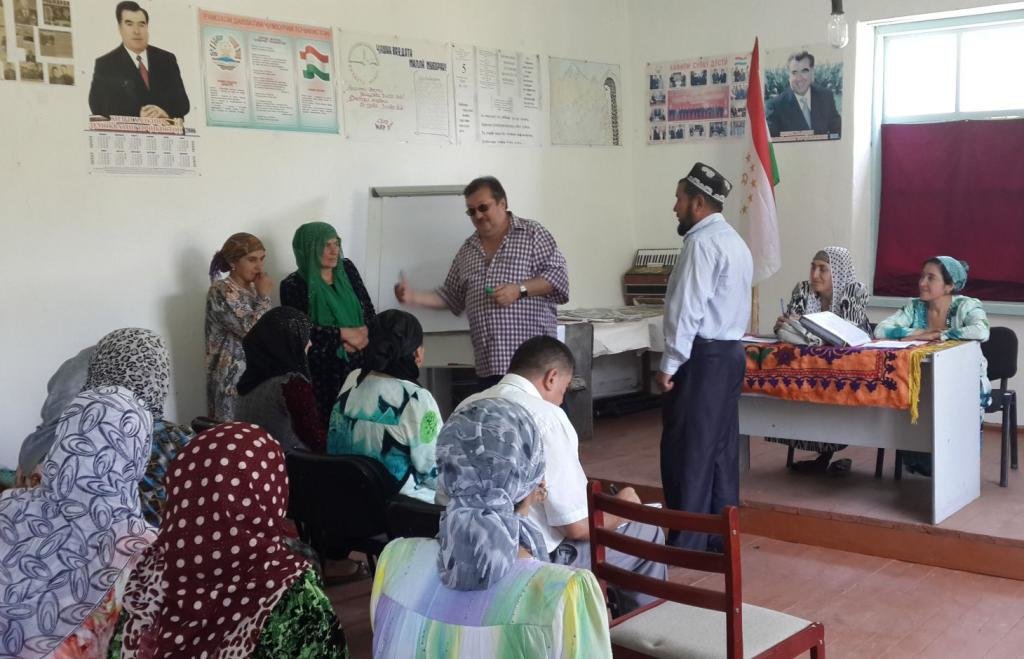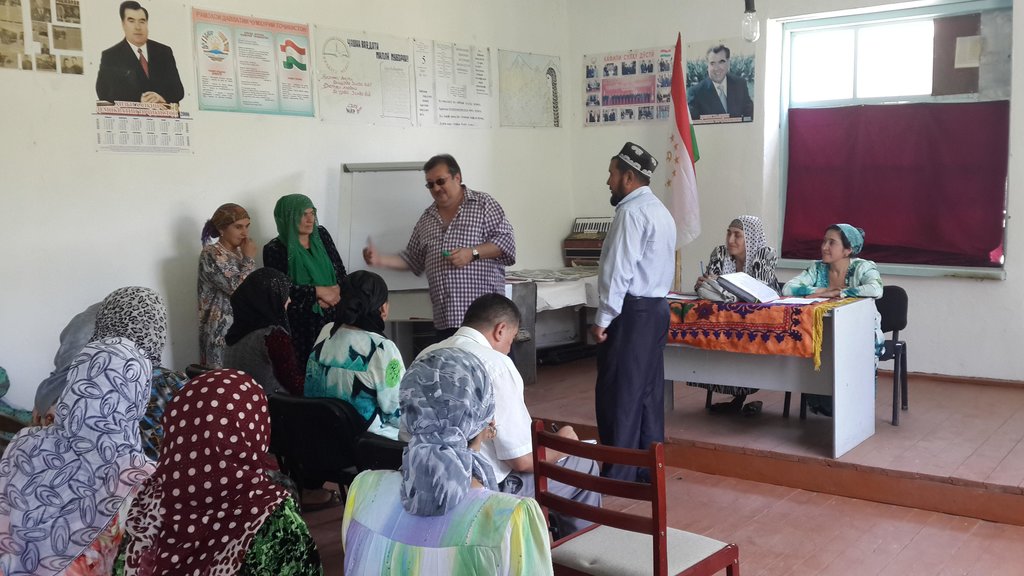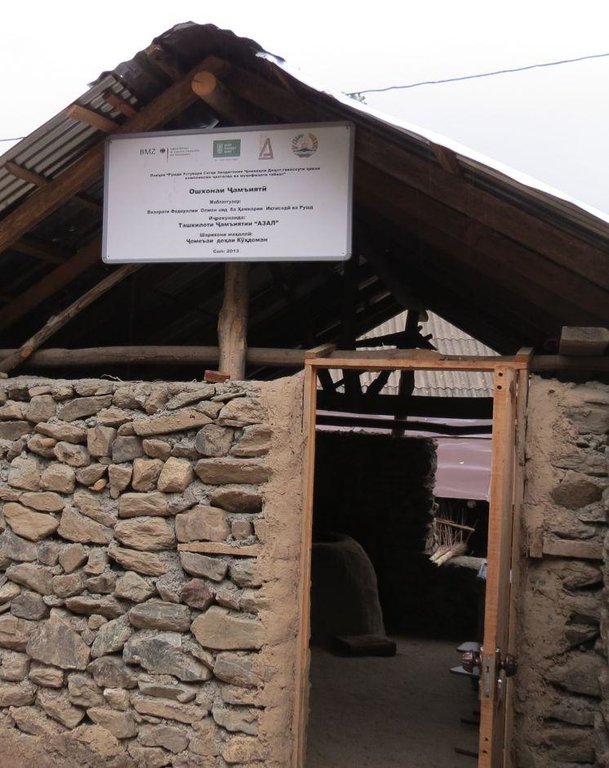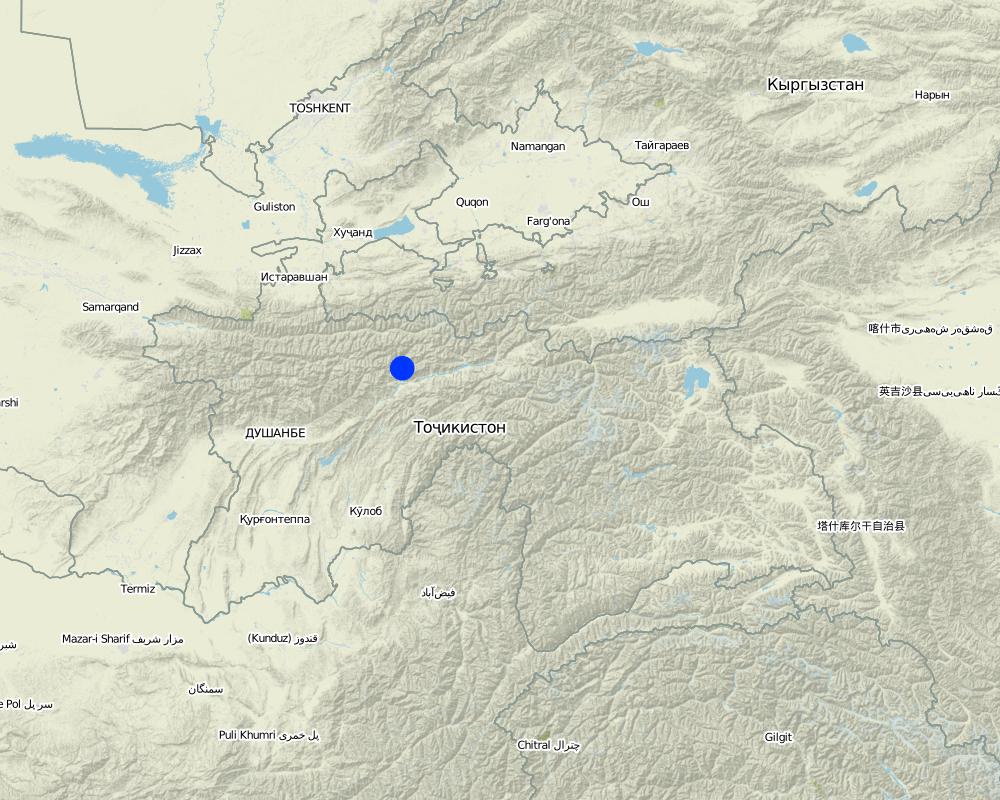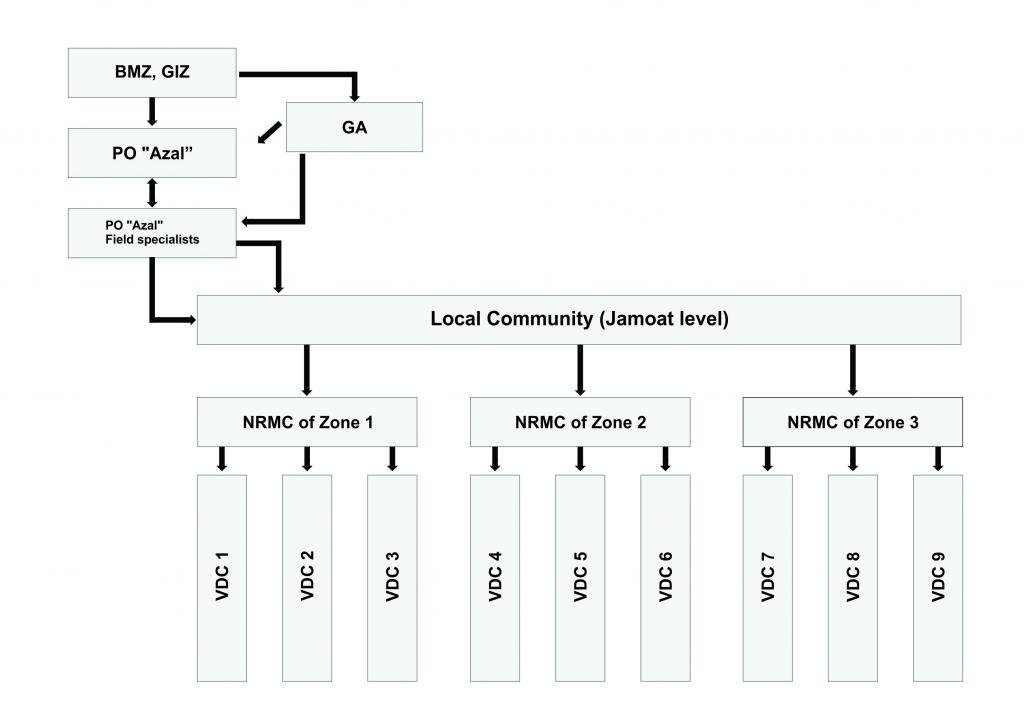The work of public bakery where local inhabitant are jointly baking bread, by using less firewood, which is not enough [Tajikistan]
- Creation:
- Update:
- Compiler: Gulniso Nekushoeva
- Editor: –
- Reviewers: David Streiff, Alexandra Gavilano
АЛОВХОНАИ ОММАВИ БАРОИ НОНПАЗИ
approaches_2526 - Tajikistan
View sections
Expand all Collapse all1. General information
1.2 Contact details of resource persons and institutions involved in the assessment and documentation of the Approach
SLM specialist:
community:
Rustamov Bakhrom
+992902555503
Community Facilitator
Tajikistan
SLM specialist:
Nazarov Sergey
+992902555505
nazarov.azal@mail.ru
Director of PO Azal
Tajikistan
Name of the institution(s) which facilitated the documentation/ evaluation of the Approach (if relevant)
Deutsche Welthungerhilfe e. V. (Welthungerhilfe) - TajikistanName of the institution(s) which facilitated the documentation/ evaluation of the Approach (if relevant)
Deutsche Gesellschaft für Internationale Zusammenarbeit (GIZ) GmbH (GIZ) - GermanyName of the institution(s) which facilitated the documentation/ evaluation of the Approach (if relevant)
Azal (Azal) - Tajikistan1.3 Conditions regarding the use of data documented through WOCAT
When were the data compiled (in the field)?
25/04/2015
The compiler and key resource person(s) accept the conditions regarding the use of data documented through WOCAT:
Yes
2. Description of the SLM Approach
2.1 Short description of the Approach
Thanks to a joint baking of a bread in public bakery by local residents, there is no need now to use a large amount of firewood, which leads to a reduction in felling of mountain forests around the village and in the leshoz area
2.2 Detailed description of the Approach
Detailed description of the Approach:
Aims / objectives: The approach was implemented by the NGO 'Azal' in 2013 within 3 years of the project Sustainable improvement of living conditions of rural communities through integrated, community-based forest protection and nature conservation, in partnership with Welthungerhilfe (GA); Donor - BMZ, GIZ, in Rasht.
Aim:Sustainable use of natural resources (SUNR) in remote mountainous areas with the involvement of the local community. Reducing of deforestation of mountain slopes and soil degradation around the village and in the leshoz area, through creation of favorable conditions for everyday household energy needs of the local population through the introduction of technologies with low energy consumption, and thus reducing the amount of firewood used.
Methods: Several methods were used: Organizing workshops for the local community (with the participation of all target groups (TG) representatives) raising the awareness about the consequences of uncontrolled use of natural resources (NR), identifying the existing problems in the management of the NR and the evaluation of potential protection activities for investing in technologies to reduce the amount of firewood. Demonstration posters, video clips about existing energy-efficient ways for mitigation. The decision support. Reveal what kind of knowledge is community needed and carried out the necessary trainings for them on energy saving , agro-forestry, agribusiness development; as well as trainings to strengthen the capacity of leshoz workers on protection and restoration of forests, visiting other leshozes with best practices.
For facilitation the management of NR the Jamoat territory have been divided into zones. For each zone, natural resources management committee (NRMC) is created.
Development of a joint action plan for the SLM, monitoring progress and problems.
Stages of implementation: 1. Selection of local community at the village level, located near the forestry. Signing the agreement on jamoat. 2. Meetings with representatives of various TG of local community to familiarize them with the aim and objectives of the project. 3. Assessment of the village NR condition with them, identify existing ecological problems. 4. discussing and identifying potential environmental protection activities for investment. 5. prioritization of the problem and a final decision of the ways how to overcome it. 5а. Also reveal what kind of knowledge on SLM is necessary for the local community and leshoz staff and conducting trainings for them. 6. establishment of a Natural Resources management committee (NRMC). 7.drawing up the programm for joint work on the project implementation, its coordination in Jamoat. 8. Implementation of planned activity under the leadership of NRMC. 9. monitoring, evaluation, reporting. 10. Transmission to the local community.
Role of stakeholders: -PO 'Azal' - the local partner –implementation on project, organization of trainings, facilitation of decision-making on SLM, providing with materials, monitoring.
-Jamoat- not financially involved, but as a local decision makers -assistance conduct work through permission for, signing documentations.
- NRMC - coordinate all works on SLM of they zone, documentation on deposits, mobilization of community .
-VDC and their women subcommittee, Mullah, representatives of leshoz, teachers -were actively involved in project implementation.
-Local community - was actively involved in the project and carry out all kinds of construction works.
Other important information: Forest area in Tajikistan is not large, and every year the area became greatly reduced because of cutting down the trees for firewood (heating, cooking and baking of bread). Bread occupies an important place in the diet of rural communities.
2.3 Photos of the Approach
2.5 Country/ region/ locations where the Approach has been applied
Country:
Tajikistan
Region/ State/ Province:
Tajikistan Regions under Republic sub-coordination (RRS)
Further specification of location:
Rasht, jamoat Rakhim-zoda,v.Kukhdoman
Comments:
There are 60 households in the Kuhdoman village , which is located next to the leshoz (Kamarov). 25 of them are covered by this approach (42%)
Map
×2.6 Dates of initiation and termination of the Approach
Indicate year of initiation:
2013
Year of termination (if Approach is no longer applied):
2014
2.7 Type of Approach
- project/ programme based
2.8 Main aims/ objectives of the Approach
The Approach focused mainly on SLM with other activities (energy saving, reduction of cutting down the trees, reducing firewood consumption and reducing expenses of time for rural women.)
The purpose of public bakery: Reducing the needs of the local population of firewood by modifying the tandur and the approach: the transition from traditional individual energy-intensive method of baking bread with many private tandurs – to the public bakery with one public energy saving Tandur
The SLM Approach addressed the following problems: Poor control (forest management) due to limited capacity and limited financial resources for SLM, aggravated by limited power supply (5hours a day in coil season), and lack of funds for buying firewood and coal by local community, for a long heating period 5 -6 months in remote mountain villages, leads to uncontrolled deforestation around the villages. Overgrazing, trampling of seedlings, etc. All this hinders natural regeneration of forests and leads to a strong reduction of it’s area and to severe soil degradation and to soil fertility decline.
Social and gender inequality and the high degree of vulnerability of poor households.
Ineffective use of firewood at home.
2.9 Conditions enabling or hindering implementation of the Technology/ Technologies applied under the Approach
social/ cultural/ religious norms and values
- hindering
Vulnerable groups, especially families where the head is a female widow, do not actively participate in the decision making process and can not put into practice methods of SLM. Because substantially all of the problems and their solutions are discussed traditionally by men in the mosque after completion of all works and evening prayer.
Treatment through the SLM Approach: First of all to support the implementation of the financial practices of SLM on the lands of the vulnerable groups of community (or with their involvement) and to organize workshops on the place where they could also participate on decision-making process.
availability/ access to financial resources and services
- hindering
A single household can not invest money on energy saving tandur. For baking large size breads they need a large size tandur, which they can buy only in Dushanbe but this is very expensive for them.
Treatment through the SLM Approach: For the wide dissemination of this technology, it is to establish such tandurs sale in the local market.
institutional setting
- hindering
Potential of Jamoats on joint planning and implementation of SLM measures is weak.
Treatment through the SLM Approach: Under this approach, a program of joint actions of villagers and NRMC were developed during meetings involving all TG, and is coordinated with jamoat.
legal framework (land tenure, land and water use rights)
- enabling
The existing land ownership, land use rights / water rights helped a little the approach implementation: The legislative framework should in principle contribute. Many laws have been adopted, but in fact they do not work, there is not enough control over their implementation
3. Participation and roles of stakeholders involved
3.1 Stakeholders involved in the Approach and their roles
- local land users/ local communities
Residents of the village over 18 years
Jamoat, and Village Development Commity
Local authorities: Mullah, the spiritual leader of the village, initiative activists
About 35% of the population of the village are poor, they are involved in the process of implementing the approach, as well as the families where head is woman (widows).
local community have made a labor contribution to the project implementation - carries out all construction works on the bakery
In this case, the decision was made with the participation of a large number of women, as it is about the bakery (purely female occupation) but usually to solve the problems of the village women are rarely invited.
Usually all the problems are discussed by men after the prayer in the mosque (the largest room and convenient to talk), where women are not able to be at this time, later they are informing about the decision.
- SLM specialists/ agricultural advisers
SLM experts from leshoz.
- teachers/ school children/ students
Director of the school and the teacher of biology
- NGO
Experts at the national level in the framework of the NGO 'Azal' used this approach several times in practice, with some modifications taking into account the traditional features and climate of RRS.
- local government
Representatives from Jamoat and local police
- national government (planners, decision-makers)
Engineer for advice on construction works
- international organization
BMZ, GIZ
Sponsoring
Specialists from German Agro Action (GA) and GIZ, developed this approach- the joint decision making through the involvement of all the target groups. Educational modules for training on assessment of problems also designed the GA.
- rural women who moved to the city last 22 years
The Joint (alternately) baking bread approach were developed by women migrated from rural to urban high-rise buildings in the last 22 years.
3.2 Involvement of local land users/ local communities in the different phases of the Approach
| Involvement of local land users/ local communities | Specify who was involved and describe activities | |
|---|---|---|
| initiation/ motivation | external support | meetings with farmers with the help of the VDC. Explanation of the goal and objectives of the project by NGO 'Azal' specialists. |
| planning | interactive | Joint work plans with the local community (representatives of all target groups(TG) |
| implementation | interactive | Local community- Provision of labor, construction of buldings, participation in trainings. -NGO 'Azal' - purchase and delivery of the necessary building materials and the large size tandur |
| monitoring/ evaluation | interactive | Monitoring is carried out mainly by NGO 'Azal' experts and rarely by representatives of German Agro Action. Data collection and data entry to the Database. From the local community side: Cooperation on monitoring and evaluation. |
| Research | none | research was not carried out |
3.3 Flow chart (if available)
Description:
In order to facilitate the management of natural resources the Jamoat Rakhim-zoda territory was divided into zones. One zone includes the three-four villages (21 village= 6 zones). For each zone, a natural resources management committee (NRMC) is created. Which includes chairmens of the existing VDC (Village Development Committee) of villages. Thus the NRMC combines both these structures and can jointly solve many ecological problems both within villages and between the villages on Jamoat.
Author:
Nekushoeva Gulniso (gulniso @mail.ru)
3.4 Decision-making on the selection of SLM Technology/ Technologies
Specify who decided on the selection of the Technology/ Technologies to be implemented:
- mainly land users, supported by SLM specialists
Explain:
On workshops involving all TG , the NGO 'Azal' specialists has been given all information gathered in the assessment of the problems of natural resources (forests, soil, etc.) around the village Kuhdoman and on jamoat in general. Also, information on available technologies that can help mitigate them.
Land users rate them and choose the most environmentally and economically acceptable.
Decisions on the method of implementing the SLM Technology were made by mainly by SLM specialists with consultation of land users. Experts after consultation with land users decide where they will build a bakery, calculate the number of required materials,size of bakery, size of roof, thickness and height of the walls etc.
Land users decide who will use this bakery, selected a woman responsible for her, build a bakery, in consultation with experts.
4. Technical support, capacity building, and knowledge management
4.1 Capacity building/ training
Was training provided to land users/ other stakeholders?
Yes
Specify who was trained:
- land users
- field staff/ advisers
- leshoz (forestry department staff)
If relevant, specify gender, age, status, ethnicity, etc.
All the TG available in the community, mostly more than 18 years old. Women and men were invited.
Form of training:
- on-the-job
- farmer-to-farmer
- demonstration areas
- public meetings
Subjects covered:
trainings were mainly conducted on SLM: energy saving at home, on sustainable forest management, aforestation, on agroforestry system, on development agro business.
4.2 Advisory service
Do land users have access to an advisory service?
Yes
Specify whether advisory service is provided:
- on land users' fields
Describe/ comments:
Visiting and advising of leshoz staff and approach from farmer-farmer: Key elements: The exchange of experience between forestries on forest rehabilitation, measures to combat diseases and pests, creating a seedlings nursery, consultation of community how various methods of energy saving can be used , visiting demonstration sites with examples of best practices.
Advisory service is quite adequate to ensure the continuation of land conservation activities; mainly by national NGOs and six NRMC which are created on Jamoat territory can continue this, if they can win grants or by implementation of fundraising in the community.
4.3 Institution strengthening (organizational development)
Have institutions been established or strengthened through the Approach?
- yes, moderately
Specify the level(s) at which institutions have been strengthened or established:
- local
Specify type of support:
- capacity building/ training
Give further details:
Trainings and consultations for leshoz staff concerning reforestation were conducted, also they visited the Vahdat leshoz nursery to get acquainted with a good experience, technical assistance to increase the area leshoz nursery have been done.
4.4 Monitoring and evaluation
Is monitoring and evaluation part of the Approach?
Yes
Comments:
bio-physical aspects were regular monitored by project staff, government through observations; indicators: areas of planting seedlings and areas with illegal cutting down the trees.
bio-physical aspects were regular monitored by government through measurements; indicators: by leshoz specialists
technical aspects were regular monitored by project staff, land users through observations; indicators: Сроки строительства, изменения в графике работ
technical aspects were regular monitored by land users through measurements; indicators: Number of purchased and spent materials
economic / production aspects were regular monitored by project staff through observations; indicators: When public bakery will start it’s work- real decreasing the amount of firewood on this 25 households
economic / production aspects were regular monitored by other through measurements; indicators: monitoring of availability of bakery to all these 25 households
no. of land users involved aspects were ad hoc monitored by project staff through observations; indicators: NRMC, etc
no. of land users involved aspects were regular monitored by None through measurements; indicators: None
management of Approach aspects were regular monitored by None through observations; indicators: None
There were no changes in the Approach as a result of monitoring and evaluation: None
There were no changes in the Technology as a result of monitoring and evaluation: None
4.5 Research
Was research part of the Approach?
No
5. Financing and external material support
5.1 Annual budget for the SLM component of the Approach
If precise annual budget is not known, indicate range:
- 2,000-10,000
Comments (e.g. main sources of funding/ major donors):
Approach costs were met by the following donors: international ( GIZ and BMZ ): 70.0%; international non-government (the German Agro Action (GA)): 30.0%; national non-government (NGO - Public Organization 'Azal'); local government (district, county, municipality, village etc) (jamoat); local community / land user(s) (mainly in the form of labor input and construction works.)
5.2 Financial/ material support provided to land users
Did land users receive financial/ material support for implementing the Technology/ Technologies?
No
5.3 Subsidies for specific inputs (including labour)
- equipment
| Specify which inputs were subsidised | To which extent | Specify subsidies |
|---|---|---|
| not financed | ||
| Buying and delivery by Kamaz tandur etc. Dushanbe | fully financed | |
- construction
| Specify which inputs were subsidised | To which extent | Specify subsidies |
|---|---|---|
| stone | fully financed | roofing iron, cement, wood, stones etc. |
| wood | fully financed | |
If labour by land users was a substantial input, was it:
- voluntary
Comments:
Local community carried out all construction voluntarily because they further will use this bakery
70% of the costs were covered by NGO (2000E) and 30% by local community in the form of labor input and the providing all kind of tools – trucks, shovelst, picks, hammers, etc.
Labour is also rewarded with other material support
5.4 Credit
Was credit provided under the Approach for SLM activities?
No
6. Impact analysis and concluding statements
6.1 Impacts of the Approach
Did the Approach help land users to implement and maintain SLM Technologies?
- No
- Yes, little
- Yes, moderately
- Yes, greatly
Yes, because they began together, with the participation of all the target groups (TG), to solve the local problems of natural resource management, and now they have chosen the NRMC- which duty is to coordinate the SLM in each zone.
Did the Approach empower socially and economically disadvantaged groups?
- No
- Yes, little
- Yes, moderately
- Yes, greatly
These 25 households included the poor and the middle income, and the families where the head are women (widows, etc),
Did the Approach improve issues of land tenure/ user rights that hindered implementation of SLM Technologies?
- No
- Yes, little
- Yes, moderately
- Yes, greatly
land ownership does not hinder the implementation of resource-saving measures
Did other land users / projects adopt the Approach?
- No
- Yes, little
- Yes, moderately
- Yes, greatly
Later NGO 'Azal' implemented the same approach in jamoat Mienadu on Tawil-Dara district, with the same number of households
Did the Approach lead to improved livelihoods / human well-being?
- No
- Yes, little
- Yes, moderately
- Yes, greatly
decreased amount of firewood needed for baking bread for the family, which can be spent on heating the living rooms, cooking a variety of food for the family but so far only for 42% households of the village
Did the Approach help to alleviate poverty?
- No
- Yes, little
- Yes, moderately
- Yes, greatly
the whole approach has helped to reduce by 30% the amount of firewood used and the time of their collection, these families now have the opportunity to have often fresh bread. More than 50% of the diet of the rural population in Tajikistan is the bread and flour dishes. The released money and time, poor families can spend on other purpose
6.2 Main motivation of land users to implement SLM
- increased production
fresh testy bread every 2 days, cheap production
- increased profit(ability), improved cost-benefit-ratio
less spend of firewood and less spend of money
- reduced workload
less time spent on collecting firewood
- well-being and livelihoods improvement
меньше тратится время на выпечку хлеба, пекут чаще , он всегда теперь свежий
6.3 Sustainability of Approach activities
Can the land users sustain what has been implemented through the Approach (without external support)?
- yes
If yes, describe how:
They now elected their NRMC (natural resources management commity), they have weight, because there are all chairmen VDO-s.They can together with the community make decision on the further introduction of energy saving through fundraising or base on the submission of proposals for small grants.
6.4 Strengths/ advantages of the Approach
| Strengths/ advantages/ opportunities in the land user’s view |
|---|
|
Reducing the trees cutting down, promote strengthening of slope lands, retain the unique native environment of Kamarov How can they be sustained / enhanced? 1. to grow up fast-growing tree species - poplar and willow on all available pieces of land close to the water and along irrigation canals 2. apply the complex of energy-saving technologies especially within the houses. |
|
Achieving reduction of firewood use and reducing financial expenses and labor inputs for harvesting woods How can they be sustained / enhanced? It should be further implemented as well: 1. Creation of joint projects leshozes and school to involve youth in the process of forest protection, 2.farmer schools for SLM- based on school land (cultivation of vegetables and flowers in the open field and in greenhouses, drip irrigation, poultry and etc ...) |
| Strengths/ advantages/ opportunities in the compiler’s or other key resource person’s view |
|---|
|
Since the implementation of resource-saving technologies, this approach provides a guarantee for the sustainable management of mountain forests, this bakery demonstrate that it is possible to start saving the forest. How can they be sustained / enhanced? This approach should be widely promoted and introduced. As well as other energy-saving technologies (insulation of houses, energy-saving stoves, introduction of solar panels, a solar greenhouses). |
|
Аssessment of the local ecological situation and causes of its worsening jointly by all TG creates conditions for increasing sustainability of mountain forests management in future. How can they be sustained / enhanced? Widely implement joint forest and pasture management approaches with involvement of all TG of the local community. |
|
The participation of all TG of the community in decision-making process and the choice of SLM technologies to solve specific environmental problems increases their awareness and responsibility for their actions How can they be sustained / enhanced? wider use of power and authority of the NRMC and VDCs and to attract all TG to the decision making process. |
6.5 Weaknesses/ disadvantages of the Approach and ways of overcoming them
| Weaknesses/ disadvantages/ risks in the land user’s view | How can they be overcome? |
|---|---|
| Many villages could independently implement such a bakery, but it is difficult to find a big size tandur on the local market | Several villages can together make order for local businessmen to bring from Dushanbe a large size tandurs for them |
| Weaknesses/ disadvantages/ risks in the compiler’s or other key resource person’s view | How can they be overcome? |
|---|---|
| Would be useful for NRMC and VDC to make trainings on preparation of project proposals to address environmental issues and submit them to international organizations such as the GA, GIZ, UNDP |
For implementation the energy-saving technologies, solar panels, etc. Or for training of a group from local community for making such tandurs, and the opening of shops of their production, according stoves (3 x1), thermal insulation of houses in Rasht |
| Would be good in the framework of this approach- the construction of the public bakery, to reinforce the use of other energy-saving measures as a complex | To apply an integrated energy-saving approach on community level - building a public bakery, as well on individual level - energy-saving winter furnace (3 in 1), the thermal insulation of houses. Then save the wood will be more noticeable and recognized. |
7. References and links
7.2 References to available publications
Title, author, year, ISBN:
reports and database OO 'Azal'
Available from where? Costs?
in PO «Azal» office
Title, author, year, ISBN:
Video clip about the public bakery produced by GIZ
Available from where? Costs?
in GIZ office
Links and modules
Expand all Collapse allLinks
No links
Modules
No modules


